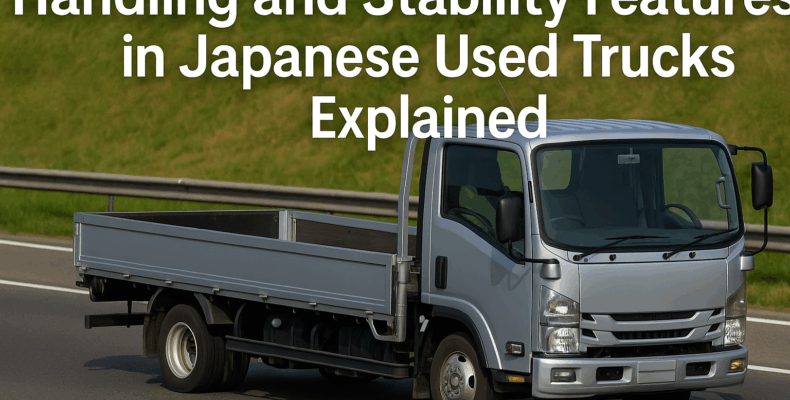Driving a truck is very different from driving a car. The size, weight, and road conditions make handling and stability essential—especially when transporting goods through tight urban roads, winding mountain routes, or off-road paths.
Thankfully, Japanese used trucks are built with smart engineering that helps drivers maintain full control, no matter the challenge. Models like the Isuzu ELF, Hino Dutro, and Mitsubishi Fuso Canter are designed with precise steering, strong suspension systems, and advanced stability features.
Let’s explore the systems behind these trucks and how they help drivers stay safe, stable, and efficient.
🚚 Why Handling and Stability Matter
Good handling keeps your truck easy to steer, while strong stability prevents tipping or skidding. These two factors work together to:
-
Reduce driver fatigue
-
Improve road grip on curves and slopes
-
Prevent accidents, especially under heavy load
-
Keep cargo secure and balanced
In fact, poor handling is one of the leading causes of commercial vehicle incidents. So choosing a truck with the right features is not optional—it’s essential.
✅ Key Handling Features in Japanese Trucks
1. Power Steering with Variable Assist
Modern Japanese trucks use power-assisted steering that adjusts based on speed.
At low speeds, the steering feels lighter—perfect for city driving.
At high speeds, the system tightens for better control.
-
Makes parking and turning easier
-
Reduces shoulder and arm strain
-
Helps maintain stability on highways
2. Short Wheelbase and Tight Turning Radius
Smaller trucks like the Toyota Dyna and Daihatsu Hijet have short wheelbases.
This gives them excellent turning ability in narrow streets or work zones.
-
Useful for delivery routes
-
Less risk of hitting curbs or obstacles
-
Improves off-road maneuverability
Even mid-sized trucks like the Hino Dutro offer excellent maneuverability compared to competitors.
3. Precision Rack-and-Pinion Steering
Unlike old-style gear systems, rack-and-pinion steering allows smoother control.
It improves handling response, especially during lane changes or sudden turns.
-
Reduces lag between steering wheel and wheel movement
-
Keeps the truck stable during sharp maneuvers
-
Supports safer operation on busy roads
🛞 Stability Features That Make a Difference
1. Anti-Roll Bars (Stabilizer Bars)
These bars connect opposite wheels and reduce body roll during cornering.
They keep the chassis level—even when the truck is partially loaded.
-
Better control during turns
-
Less side-tilt under uneven loads
-
Improves passenger comfort in crew cabs
2. Suspension Systems Built for Load Balance
Most Japanese trucks use leaf spring or coil spring suspensions, depending on the model size.
-
Leaf springs provide heavy load support
-
Coil springs offer comfort and flexibility
-
Shock absorbers reduce bounce and vibration
Together, these systems help maintain grip and control on bumpy or sloped roads.
3. Electronic Stability Control (ESC)
ESC prevents loss of traction by applying brakes to individual wheels.
-
Reduces chance of skidding or jackknifing
-
Automatically adjusts during turns or wet roads
-
Especially helpful in icy, rainy, or gravel conditions
Some trucks also include Hill Start Assist to prevent rollback when starting on slopes.
4. Tire Grip and Load Distribution
Tire quality and layout impact both handling and stability.
-
Japanese trucks come with load-rated commercial tires
-
Dual rear wheels offer more balance under weight
-
Even load distribution keeps center of gravity low
Exporters often upgrade tires before shipment—so ask for tire photos and specs.
🌍 Global Buyers: What to Check Before Importing
Before buying your next truck, ask the exporter:
-
Does it have ESC or anti-roll bars?
-
What type of suspension system is used?
-
Is the power steering hydraulic or electric?
-
Can I request stability upgrades before export?
👉 For peace of mind, choose from this trusted list:
Top 5 Trusted Japanese Used Truck Exporters for Global Buyers
These suppliers offer full mechanical checks, road test videos, and part replacements if needed.
✅ Final Thoughts
Every road has its challenges—sharp turns, steep hills, or sudden stops. That’s why handling and stability features in Japanese used trucks are so important.
From tight steering systems to anti-roll bars and smart suspensions, these technologies help drivers stay safe and confident.
Whether you’re driving in the city or far off the road, choosing a truck with excellent control features will protect your cargo, your business, and your peace of mind.
